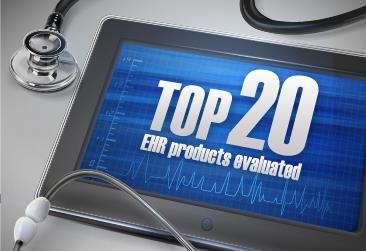Electronic health record (EHR) vendors are required to test their products for usability, but how closely are these requirements being followed? A new comparative evaluation published Tuesday is intended to promote transparency around the design and usability testing of EHR products. Here is how 20 of the most common products measured up.
Falling short
The AMA and MedStar Health’s National Center for Human Factors in Healthcare developed an EHR User-Centered Design Evaluation Framework to compare the design and testing processes for optimizing EHR usability. Using data provided by vendors to meet the certification requirements set by the Office of the National Coordinator for Health Information Technology (ONC), the framework employs a 15-point scale intended to go beyond the ONC’s criteria and evaluate EHR vendors’ compliance with best practices for a user-centered design process to encourage the ONC to raise the bar on federal usability certification.
 Effective usability is critical to patient safety and physician satisfaction. In 2013, a study from the AMA and the RAND Corporation found that EHR usability represents a unique and vexing challenge to physician professional satisfaction. The framework analysis showed a lack of focus on user-centered design and usability testing among a large majority of the 20 EHR products.
Effective usability is critical to patient safety and physician satisfaction. In 2013, a study from the AMA and the RAND Corporation found that EHR usability represents a unique and vexing challenge to physician professional satisfaction. The framework analysis showed a lack of focus on user-centered design and usability testing among a large majority of the 20 EHR products.
Out of those 20 products evaluated, only three met each of the basic capabilities measured. View the assessment for full results on all 20 products.
A call to raise the bar
Thorough user-centered design and testing for EHR products is essential when developing useful tools that will improve patient safety and meet the work flow and information needs of today’s practice. Because the ONC does not have many of the measurements for best practices implemented in their certification process, many EHR products become certified without meeting practical usability necessities required for EHRs to work in the ways physicians and patients need them to each day.
“Physician experiences documented by the AMA demonstrate that most EHR systems fail to support effective and efficient clinical work, and continued issues with usability are a key factor driving low satisfaction with many EHR products,” AMA President Steven J. Stack, MD, said in a news release. “Our goal is to shine light on the low-bar of the certification process and how EHRs are designed and user-tested to drive improvements that respond to the urgent physician need for better designed EHR systems.”
Advancements in health IT, like EHRs, are supposed to make clinical work flow more fluid and practical. Yet, the EHR products evaluated failed at the most basic levels of usability and have added frustration to the delivery of effective, quality patient care.
“Alignment with best practices for user-centered design and testing is a starting point that regulators and industry should meet and exceed,” said Raj Ratwani, PhD, scientific director of the Human Factors Center and principle developer of the framework. “The framework we developed is the first step in bringing greater transparency to the usability processes of EHR vendors.”
The framework builds on a study on EHR usability that was published by JAMA in September. In that study, Ratwani and colleagues analyzed available reports from the top 50 EHR vendors as measured by the number of meaningful use attestations made to the ONC between Apr. 1, 2013, and Nov. 30, 2014. The researchers found that a significant percentage of vendors did not even follow basic federal requirements for certifying the usability of their products, yet these products were certified under the meaningful-use incentive program.
The AMA will continue to move aggressively to advance the goal of more usable EHR products based on eight usability priorities created last year by the AMA to lead EHR design improvements that would ultimately improve the health of the nation.
Speak up and slow down meaningful use
This data is yet another step on the EHR solution ladder. The Centers for Medicare & Medicaid Services (CMS) recently released meaningful use Stage 3 requirements against the recommendation of the AMA and physicians nationwide. Within the new rule, a 60-day comment period was incorporated as well as an extension of the compliance deadline to 2018.
As part of its Professional Satisfaction and Practice Sustainability initiative, the AMA will continue to work with physicians, vendors, policymakers, health care systems and researchers to make EHR improvements that can reduce the physician burden while advancing the delivery of high-quality affordable care and increasing access to medical records.
Now is your chance to speak up. Each additional voice raises the volume of the cause. Visit breaktheredtape.org to share your story about how regulations are affecting your patients and practice, and submit your comments on the new meaningful use rules directly to CMS.




